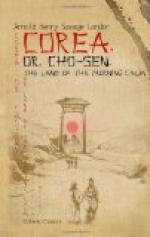When visiting Seoul, it is well worth one’s while to take a walk to the Pekin Pass, a li or two outside the West Gate. The pass itself, which is cut into the rock, is situated on the road leading from Seoul to Pekin; which, by the way, is the road by which the envoys of the Chinese Emperor, following an ancient custom, travel overland with a view to claiming the tribute payable by the King of Corea. As a matter of fact, this custom of paying tribute had almost fallen into disuse, and China had not, for some years, I believe, enforced her right of suzerainty over the Corean peninsula, until the year 1890, when the envoys of the Celestial Emperor once again proceeded on their wearisome and long journey from Pekin to the capital of Cho-sen. It was here at the Pekin Pass, then, that, according to custom, they were received with great honour by the Coreans, and led into Seoul. It was at a large house, surrounded by a wall, on the road side, that these envoys were usually received and welcomed, either by the king in person or by some representative; and it was here that they were treated with refreshments and food, previously to being conducted in state into the capital, this being accomplished amidst the cheers of a Corean crowd, which, like other crowds, is always ready to cheer the last comer. At the Pekin Pass, a “triumphal arch”—for want of a better word—could be seen. It was a lofty structure, composed of two high columns, the lower part of these being of masonry, and the upper of lacquered wood, which supported a heavy roof of the orthodox Corean pattern, under which, about one-fourth down the columns, was a portion decorated with native fretwork of a somewhat rough type. The illustration represents this monument as it appeared in winter time, when the ground was covered with snow, beyond it being the square cut in the rocks, through which the road leads to Newchuang and Pekin.
There are two types of individuals that are very interesting from a picturesque point of view; viz., the water-coolie, and the man who carries the huge locks and keys of the city gates.
The water-coolie is almost as much of a “personality,” as the mapu, in his rude independent ways. He displays much patience, and certainly deserves admiration for the amount of work he daily does, for very little pay. His work consists in carrying water, from morning until night, to whoever wants it. This is a simple enough process in summer time, but in winter matters are rather different, for now nearly all the fountains are frozen, and the water has to be drawn from a well. The water-coolie carries a peculiar arrangement on his shoulders, a long pole fastened cross-wise upon his shoulder-blades, by straps going under and round the arms; by which means he is enabled to carry two buckets of water at a time. The arrangement, though more complicated, is not dissimilar to that used for the same purpose, by women in Holland, or to that for carrying milk




